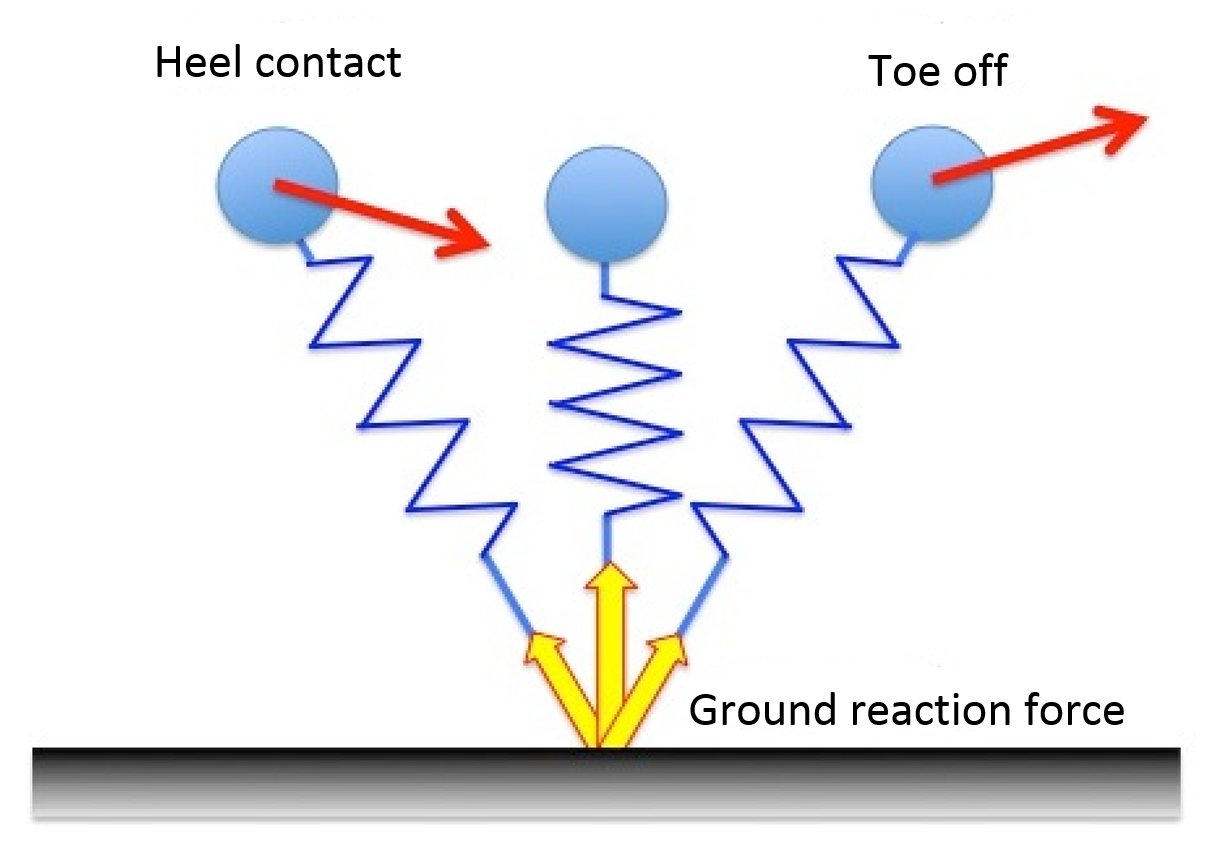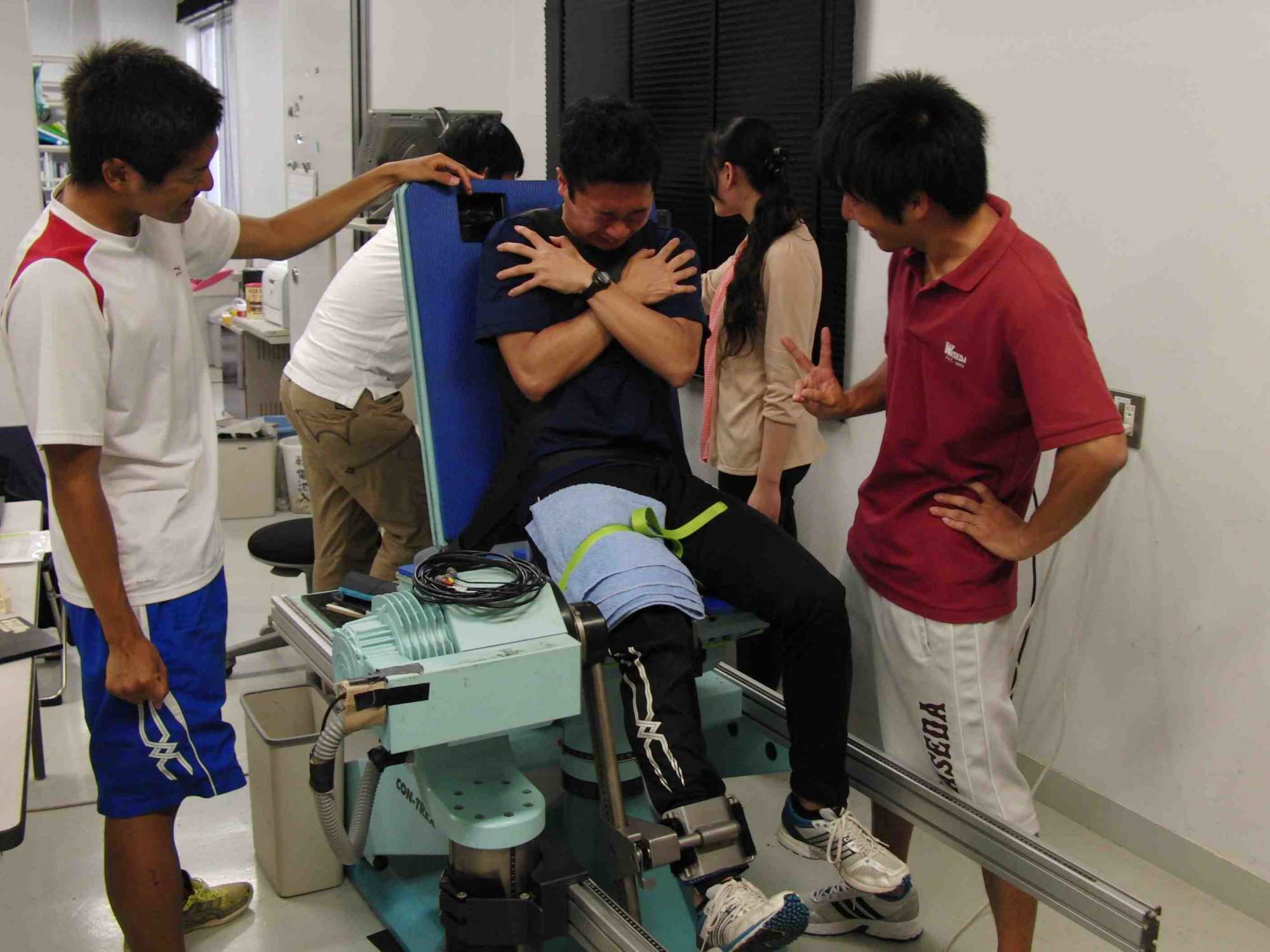Waseda Frontline Research Vol. 7, Part 2 – Can science win medals? Using science at the 2020 Tokyo Olympics!
Thu, Jan 21, 2016-
Tags
Exercise physiology and biomechanics researcher
Professor Yasuo Kawakami, Faculty of Sport Sciences
Winning medals with science – Gear development and revolutionary coaching

Last time I talked about our search for physical mechanisms that will help us use science to win Olympic medals. Now I would like to talk about the development of sports gear that can help us achieve this goal. We all dream about sports gear that can improve our athletic abilities such as shoes that make us faster or clothing that provides resilience and strength. However, is it truly possible for us to develop this kind of gear? We are now approaching the frontlines of a coaching revolution and moving closer to gear development that will give us an advantage at the 2020 Tokyo Olympics and Paralympics.
Is it possible to develop shoes that improve running speed?
I get this question a lot.
We are working to develop gear such as shoes and sportswear that enhances the athletic abilities of athletes and regular people. To accomplish this, we are utilizing data obtained through our efforts to understand the body’s mechanisms (as discussed in the previous article).
In my research, I have found that it would be difficult to develop a pair of shoes that can significantly improve running speed on their own. Because feet are the only part of the body that touches the ground when running, and the part of the body that transfers exerted energy to the ground, I do believe some sort of modification to shoes can have a significant impact on running. One example would be equipping shoes with powerful springs. I would like to use Oscar Pistorius as an example. Pistorius used prosthetic legs in the London Olympics. Nicknamed the “Blade Runner,” Pistorius is a below-knee amputee with carbon-fibre prosthetics attached to both legs for running. These prosthetics are powerful springs that work together with his muscles. He participated in the Olympics as well as the Paralympics in London. However, he was unable to win a gold medal in any individual event.
These springs “accumulate elastic strain energy and release it.” However, elastic strain energy requires muscle contraction energy. When competing against non-handicapped runners in the Olympics, Pistorius reached top speed from the middle of the race to the latter half. While other runners grew tired, he was able to push ahead. Pistorius’s springs allowed him to compete with other athletes for a long stretch but he struggled to keep up when explosive muscle power was required. Therefore, it is not possible to benefit from springs throughout an entire race.

(Figure 1) When a spring makes contact with the ground and is released (source: Yasuo Kawakami)
Based on these examples, we understand that in order to develop sports-enhancing gear, it is essential to develop a concept that allows energy-producing muscles and spring devices to work together effectively. In other words, a comprehensive design, which combines physical training methods and the gear-provided assistance, is what it will take to get people running faster and jumping higher. We are now conducting basic laboratory research to develop shoes based on this concept, but we are also working on a modality to reduce fatigue by manipulating body changes when exercising.
By combining both of these approaches, the search for physical mechanisms and gear development, I believe we can provide a specific type of strategic support sought after around the world. I expect this field of research will directly benefit the Paralympics. It may even lead to the discovery of future abilities and help athletes reach their full training potential.
A “Coaching Revolution” to win medals
When thinking of ways to “win medals with science,” it is important to enable athletes to feel that they are actually performing the necessary skilled movements. This is achievable through a revolutionary approach to coaching
Athletes can now use motion capture and other such technologies to improve their skills. It is also easy to compare one’s own running form with a faster athlete. However, even when utilizing the latest technologies, it is difficult to replicate the model athlete’s feeling of performing specific movements.

Professor Kawakami politely explains the details of his research. This interview was conducted at Professor Kawakami’s laboratory at Tokorozawa Campus.
When a person exercises, the cerebrum selects several muscles appropriate to any specific movement, then starts up a program that controls the timing and amount of activity. The program then performs corrections depending on muscle output. Muscles are essentially apparatuses that exert power and mechanically change the angular acceleration of joints. The brain transmits commands to nerves and hundreds of muscles throughout the body exert strength that accelerates the body or parts of the body. This conversion results in complex movements such as picking up a ball and throwing it.
When an athlete watches a video of their own movements, and their coach watches alongside them, they are mainly relying on visual information. This information is a displacement in physical quantity. Observant athletes and coaches may be able to get a good sense of time and speed from the video. However, there are probably very few, if any that can get a sense of acceleration from a video. Therefore, information from videos is clearly an insufficient method of understanding how it feels for top athletes from around the world competing for medals at the Olympics to perform complex, powerful movements.
If it were possible to analyze target movements in terms of acceleration, along with the main joints and power exertion patterns of muscles that move them, and then provide feedback to athletes in real time, we could overcome the limits of video analysis. In other words, if there was a revolution in coaching and it became possible for the brain to provide information on ideal movements and what it feels like to perform them, science could become a groundbreaking vehicle for winning medals.
Although still in the trial and error process, we hope to develop a device that accomplishes the aforementioned goal. Conducting practices, matches, and training while utilizing the cerebrum to allow us to feel what it is like to perform specific movements could lead to breakthroughs for top athletes and produce the most efficient training routines possible. If we can utilize this method for the 2020 Olympic and Paralympic games, I believe it will lead to a surge of prosperity for Japan that emanates from the world of sports.
Next time, I would like to address this question as it relates to science and the human senses: “What occurs among an athlete’s senses when they perform a miraculous feat?”
Click here for Part 1
Click here for Part 3
Click here for Part 4
Profile

Yasuo Kawakami graduated from the University of Tokyo with a degree from the Faculty of Education’s Division of Physical and Health Education (Physical Education Course) in 1988. In 1990, he acquired a Master’s Degree from the University of Tokyo’s Graduate School of Education and withdrew from the doctoral program in 1991. In 1991, he worked as an assistant at the University of Tokyo’s College of Arts and Sciences, in the Department of Health and Physical Education. In 1996, he worked as an assistant at the University of Tokyo’s Graduate School of Arts and Sciences in Multi-Disciplinary Sciences, and was promoted to assistant professor in 1999. In 2003, he became an assistant professor at Waseda University’s School of Sport Sciences. He became a professor at Waseda University’s Faculty of Sport Sciences in 2005.
Accomplishments and research
-
2015~,川上筋腱特性開拓プロジェクト, 人間の筋腱特性とその可塑性に関する包括的研究:身体運動能力との関連性からみた効果的なトレーニング方策の確立に向けて(中核研究者課題)
- 2012~2015,身体運動のメカニズムと適応性の解明:骨格筋・腱動態の生体計測によるアプローチ(科研費課題)
- 2009~2011,筋肉痛の発生機序と部位特異性:筋肉痛を抑えながら筋力増強効果を高めるトレーニング(科研費課題)
Reference
- Ema, R., Wakahara, T., Yanaka, T., Kanehisa, H., Kawakami, Y. Unique muscularity in cyclists’ thigh and trunk: a cross-sectional and longitudinal study. Scand. J. Med. Sci. Sports, 2015. doi: 10.1111/sms.12511.
- Miyamoto, N., Kawakami, Y. No graduated pressure profile in compression stockings still reduces muscle fatigue. Int. J. Sports Med. 36: 220-225, 2015. doi: 10.1055/s-0034-1390495.
- Sakaguchi, M., Shimizu, N., Yanai, T., Stefanyshyn, D., Kawakami, Y. Hip rotation angle is associated with frontal plane knee joint mechanics during running. Gait & Posture 41: 557-561, 2015. doi:10.1016/j.gaitpost.2014.12.014
- Shishida, F., Sakaguchi, M., Sato, T., Kawakami, Y. Technical principles of Atemi-waza in the first technique of the Itsutsu-no-kata in Judo: from a viewpoint of Jujitsu-like Atemi-waza. Sport Science Research 12: 121-136, 2015.
- Akagi, R., Iwanuma S., Hashizume, S., Kanehisa, H., Fukunaga, T., Kawakami, Y. Determination of contraction-induced changes in elbow flexor cross-sectional area for evaluating muscle size-strength relationship during contraction. J. Strength Cond. Res. 29: 1741-1747, 2015.
- Wakahara, T., Ema, R., Miyamoto, N., Kawakami. Y. Increase in vastus lateralis aponeurosis width induced by resistance training: implications for a hypertrophic model of pennate muscle. Eur. J. Appl. Physiol. 115: 309-316, 2015.
- Sugisaki, N., Wakahara, T., Murata, K., Miyamoto, N., Kawakami, Y., Kanehisa, H., Fukunaga, T. Influence of muscle hypertrophy on the moment arm of the triceps brachii muscle. J. Appl. Biomech. 31: 111-116, 2015. doi: 10.1123/jab.2014-0126.
 This interview took place at Tokorozawa Campus, home to the Faculty of Human Sciences and the Faculty of Sport Sciences
This interview took place at Tokorozawa Campus, home to the Faculty of Human Sciences and the Faculty of Sport Sciences














